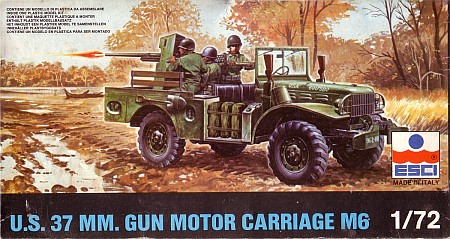|
I have always liked gun trucks and the American 37mm GMC M6 is one that I particularly like. As far as I know Esci
(and the recent Italeri re-release of the same Esci kit) are the only injected plastic offerings of this vehicle. My copy was one of the old Esci
releases that I was a very inexpensive eBay purchase.
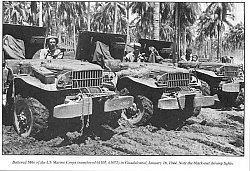 |
Inside the box are a couple of sprues containing 101 parts molded in a light tan coloured plastic. The major body
parts have a slight orange peel like roughness to them that some manufacturers use but I personally don't like. There is an instruction sheet and a
small set of decals, but no clear parts of any kind for the windshield. This will have to be cut from some acetate sheet or the like. The decals,
though nicely printed in register and quite opaque looking turned out to be unusable because the backing paper was a bit moldy and the transfers
themselves were somewhat brittle due to age and didn't like too much handling after I gave them a test soaking. Having no decals wasn't a problem.
My build was going to be similar to a trio of weary and battered looking USMC M6 training vehicles photographed on Guadalcanal, January 1944 (see photo to the left).
I found the instructions a bit confusing at first because the build sequences show all of the parts with an alphabetic character in
front of the part number. I initially thought these letters were present on the sprues but that was not the case. Eventually it dawned on me that the letter indicated
the sequence in which the parts should be joined together. Once over this minor hurdle I was ready to commence with the kit.
Fit of the kit parts is a mixture of indifferent to bad. For the most part all of the pieces and sub-assemblies needed some tweaking to fit.
|
Watch for sink holes and ejector pin marks that will need filling:
- On top of part 74 (ammunition locker)
- All over the frame (part 31)
- The undersides of the rear bed (part 99), front floor of the passenger compartment (part 25),left rear wheel well liner (part 102), right wheel well liner (part 101),
left rear bed panel (part 26) and right rear bed panel (part 27)
- Both front bumpers (part 62 & 63)
- The wheels and tires are two piece affairs. The rear pieces (parts 4, 5, 6 & 7) have ejector pin marks eqaully spaced around the circumference in the tire
sidewalls. I got lazy here and just filled one of the marks per tire where they would not be hidden by the body or fenders. The other two were just given a quick swipe with
some sandpaper to make them less obvious.
There are two small holes in the tailgate (part 21). Their existence is a mystery since there are no parts that use these holes.
I filled these and sanded them smooth.
I generally followed the sequence as laid out by the instructions. Step 1 was followed pretty much as is but I did not add the fenders (parts 37 & 38) and brush guard/grille (part 42) until later in the build. The rear wheel well liners have holes where they attach to the fenders that need to be filled. The front fenders also have holes where the headlights attach that also must be filled after the lights are in place.
Modifications to the kit were to address the items I considered major areas of concern with this kit. The first is the
suspension, which is makes the vehicle sit too tall, the second is the gun shield, which is a bit undersized, and the general thickness of the parts,
which is as expected considering this kit was first molded some 30 or so years ago.
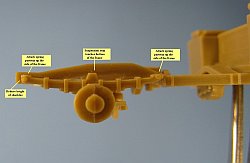
|
Step 2 is where the first major modifications were done and where the suspension was dealt with. If one follows the
instructions to the letter the kit will sit way too tall, so I had to attempt some suspension lowering ala what the car modellers do to customize their vehicles.
(refer to the pictures to the left to hopefully give you a pictorial view of the modifications).
- Step 1: Fill in the 6 mounting holes for the springs in the frame
- Step 2: Build the rear bed and add it to the frame
- Step 3: Cut off the tops of the spring shackles to the tops of the round circles that I assume represent the suspension bushings
- Step 4: There are square bumps on the tops of the axles (part 18 & 19) that are used to locate and align the axles but these need to be removed
- Step 5: Glue the rear springs to the outside of the frame such that the top of the shackles touch the underside of the rear bed
- Step 6: Cut down the length of the tie rod ends on the front axle so they don't get in the way of the axle when it's placed in its new lowered position
- Step 7: Front spring mounts such that the shackles are most of the way up the sides of the frame and the suspension travel stop touches the bottom of the frame
- Step 8: After the suspension is lowered part 61 will no longer fit as planned. I just shortened it a bit and attached it in what looked like it might be the proper place
(I expect that this procedure could also be used for the ESCI truck versions that don't sport the anti-tank gun)
|

|
After the lowering was complete I added the remainder of the suspension from Step 1. The drive shafts (parts 46 & 47) are reversed.
They will not span the distance between the transfer case (part 48) and the differentials if mounted as per the instructions.
While I waited for the suspension work to set I worked on the gun and shield, and put together most of the rear bed and the front tub.
|
I started the shield replacement by cutting out new pieces using the kit's shield as a template. The outline of one side of the shield
was traced onto plastic sheet with a mechanical pencil. This makes the replacement a bit larger than the kit part but that's not a problem because the kit's shield is a
tad too small to begin with. The original shield's roof lacked the slope that was apparent in some web drawings I found so I extended the vertical line of the shield
about 1 mm to give it more slope. I then scored along the traced lines with a steel ruler and snapped the shield piece from the plastic. Then the replacement piece was
reversed and traced onto the plastic again. It was a bit larger than the other piece due to the tracing but some trimming and sanding got it to match the other piece.
Both pieces were put back to back and the cutout for the gun was made with a hobby knife and rounded out with a round file. The two pieces were glued together with some
methylene chloride and then put over the old shield to get it to the correct angle and left to dry. Once set a rectangular piece of plastic was cut and glued to the top
of the shield. When that was dry the piece was trimmed flush to the shield and sanded. Bolts were marked and added with superglue. Next the barrel mount from the old
shield was cut out and sanded down. It was then glued to the back of the new shield to hold the gun. A drill bit was used to add a shallow hole to the gun's breech.
Afterwards braces from the gun to the back of the shield were fashioned from some plastic rod and the small box (part 69) was added to the rear of the shield. Sounds
like a lot of work but in reality it wasn't that difficult.
Next I partly built the front passenger compartment by adding the side panels (parts 1 & 2) to the tub (part 25). I had to trim the
ends of the compartment sides (parts 1 & 2) slightly as they are a bit too long and will not allow the front compartment to attach to the rear bed without some
interference. As for the kit's front seats I removed the molded on frame and added sides to the seats to make them more like the bucket style as found on the real vehicle.
I then tackled the rear bed. There are supposed to be some bench seats on top of the fenders. These were added with some plastic sheet
that was scribed to represent individual boards and then some wood grain texture was applied by scraping the edge of my hobby saw along the top of the plastic. I also
replaced the overly thick railing (parts 97 & 98) with new pieces from plastic strip. I moved the gun pedestal about 1mm to the rear to place the gun further aft
as per my drawings and trimmed the braces to more closely match my references.
A cable was added to the winch drum. For this I stripped out the inside wires from a set of ear buds. This provided a nice thin
piece of copper wire nicely wound around a threadlike interior core. A chain was draped over the front bumpers. For this I used a fine silver necklace obtained from a
Walmart jewelry section. The molded on strap on the top of the storage box (part 78) was replaced with a piece cut from lead foil. On many of my reference photos, as
well as the box top painting, there appears to be some kind of a bracket for what looks like a pail on the right front fender. I scratch built a bracket, minus the pail,
and added some straps cut from lead foil.
The kit's tarps (parts 73 & 79) are rather featureless and flat looking as are the two rifles and their sheaths (part 87). These
were left off the kit plus one of the two supplied jerry cans. The two figures were assigned to the spare parts box.
I had originally wanted to display the windshield (part 24) in the folded forward position but it would not sit fully down onto the
hood so in the end I also left it off since the picture that inspired this build showed vehicles with them removed. Thus the windshield was discarded and the holes
in the hood were filled and sanded and new smaller holes were drilled to represent the attachment points.
The grille and the light guards are a bit on the clunky side but unless you're willing to scratch build them (and I wasn't) the only
effective option is to do as I did and thin them with some scraping with a hobby knife.
The kit was painted with olive drab enamels. Markings, which consisted of just a single vehicle number on the left front bumper, were
made from a set of rub on transfers (a model railroader set by Woodland Scenics if I remember correctly) applied to some Superscale clear decal paper. The kit was
weathered and sprayed a flat coat to finish it up.
Well, it was a lot of work but the changes make it look much better than what comes out of the box. This is an old kit and it shows it's
age with the poor fit and thickly molded parts,
and as far as I know it is the only game in town if you want to have an M6 in your collection.
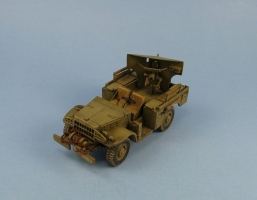
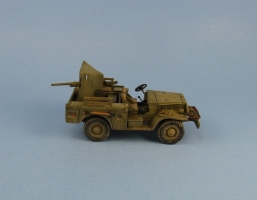
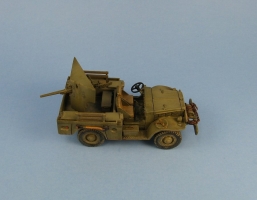
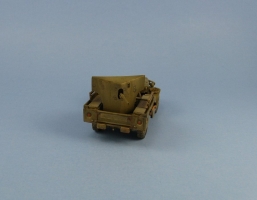
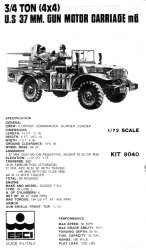
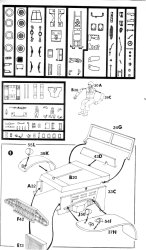
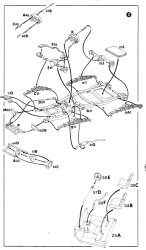
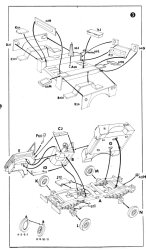
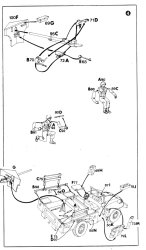
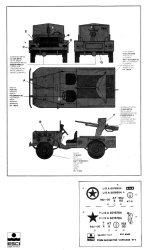
Review sample purchased by the author.
|
